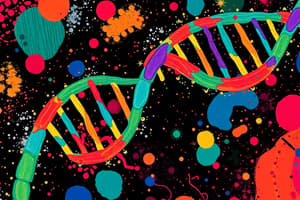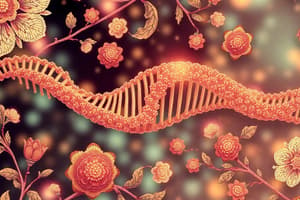Podcast
Questions and Answers
What is the role of exons in mRNA processing?
What is the role of exons in mRNA processing?
- Exons form spindle apparatus and attach to chromosomes during cell division
- Exons enable the cleavage of pre-mRNA and join to release mature mRNA (correct)
- Exons are responsible for light absorption and electron energy production in chloroplasts
- Exons carry out protein synthesis by joining amino acids into polypeptide chains
What is the composition of each ribosomal subunit?
What is the composition of each ribosomal subunit?
- mRNA and ribosomal proteins
- tRNA and amino acids
- rRNA and ribosomal proteins (correct)
- mRNA and tRNA
Where does protein synthesis occur in the cell?
Where does protein synthesis occur in the cell?
- Endoplasmic reticulum
- Nucleus
- Ribosome (correct)
- Chloroplast
What happens during Metaphase 2 of meiosis?
What happens during Metaphase 2 of meiosis?
What occurs during the light reaction in chloroplasts?
What occurs during the light reaction in chloroplasts?
What is the function of exons in mRNA processing?
What is the function of exons in mRNA processing?
What is the composition of each ribosomal subunit?
What is the composition of each ribosomal subunit?
What occurs during Anaphase 2 of meiosis?
What occurs during Anaphase 2 of meiosis?
Where does protein synthesis occur in the cell?
Where does protein synthesis occur in the cell?
What happens during the light reaction in chloroplasts?
What happens during the light reaction in chloroplasts?
Flashcards
Exon's role in mRNA processing
Exon's role in mRNA processing
Exons are coding regions within pre-mRNA that are joined together to create mature mRNA.
Composition of a Ribosomal Subunit
Composition of a Ribosomal Subunit
Ribosomal subunits are made up of rRNA (ribosomal RNA) and proteins.
Where does protein synthesis occur?
Where does protein synthesis occur?
Protein synthesis, the process of creating proteins, takes place on ribosomes.
Metaphase 2 in Meiosis
Metaphase 2 in Meiosis
Signup and view all the flashcards
Light Reaction in Chloroplasts
Light Reaction in Chloroplasts
Signup and view all the flashcards
Anaphase 2 in Meiosis
Anaphase 2 in Meiosis
Signup and view all the flashcards
Function of Exons
Function of Exons
Signup and view all the flashcards
Ribosomal Subunits
Ribosomal Subunits
Signup and view all the flashcards
Protein synthesis location
Protein synthesis location
Signup and view all the flashcards
Light Reaction purpose
Light Reaction purpose
Signup and view all the flashcards
Study Notes
Transcription and mRNA Processing
- Information encoded in DNA is made into a complementary RNA copy through transcription.
- Eukaryotic mRNAs undergo post-transcriptional modifications, including:
- Addition of a 5' prime guanine cap by a capping enzyme to protect the mRNA from degradation and facilitate translation.
- Addition of a poly-A tail by poly-A polymerase to enhance translation efficiency.
- mRNA splicing occurs through the action of a spliceosome, which removes introns and joins exons.
- The difference between pre-mRNA and mature mRNA lies in the presence of introns, which are removed during splicing to produce a translatable mRNA.
mRNA Structure and Function
- The guanine cap at the 5' end of the mRNA protects it from degradation and facilitates translation.
- The poly-A tail at the 3' end of the mRNA enhances translation efficiency.
- Mature mRNA is translated by ribosomes to produce a protein product.
RNA Interference (RNAi)
- RNAi is a mechanism of gene expression regulation that involves the silencing of specific genes.
- miRNA is a type of RNA that plays a key role in RNAi, acting as a direct silencer of specific genes.
Ribosome Structure and Function
- The ribosome is composed of a large and small subunit.
- The ribosome attaches to the mRNA and reads the sequence of nucleotides to produce a protein product.
Studying That Suits You
Use AI to generate personalized quizzes and flashcards to suit your learning preferences.




